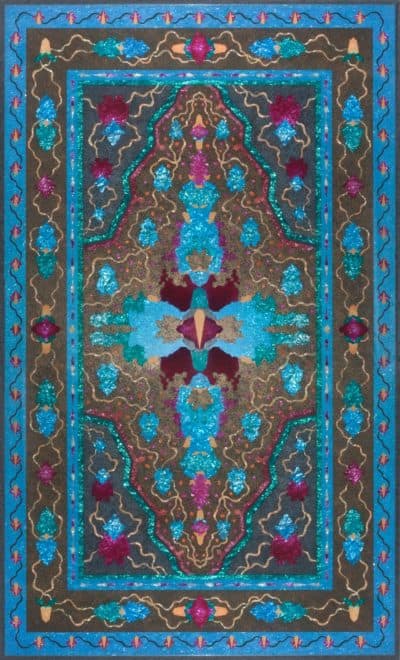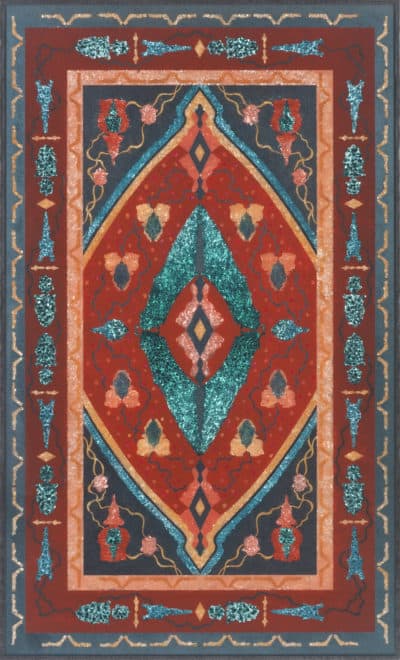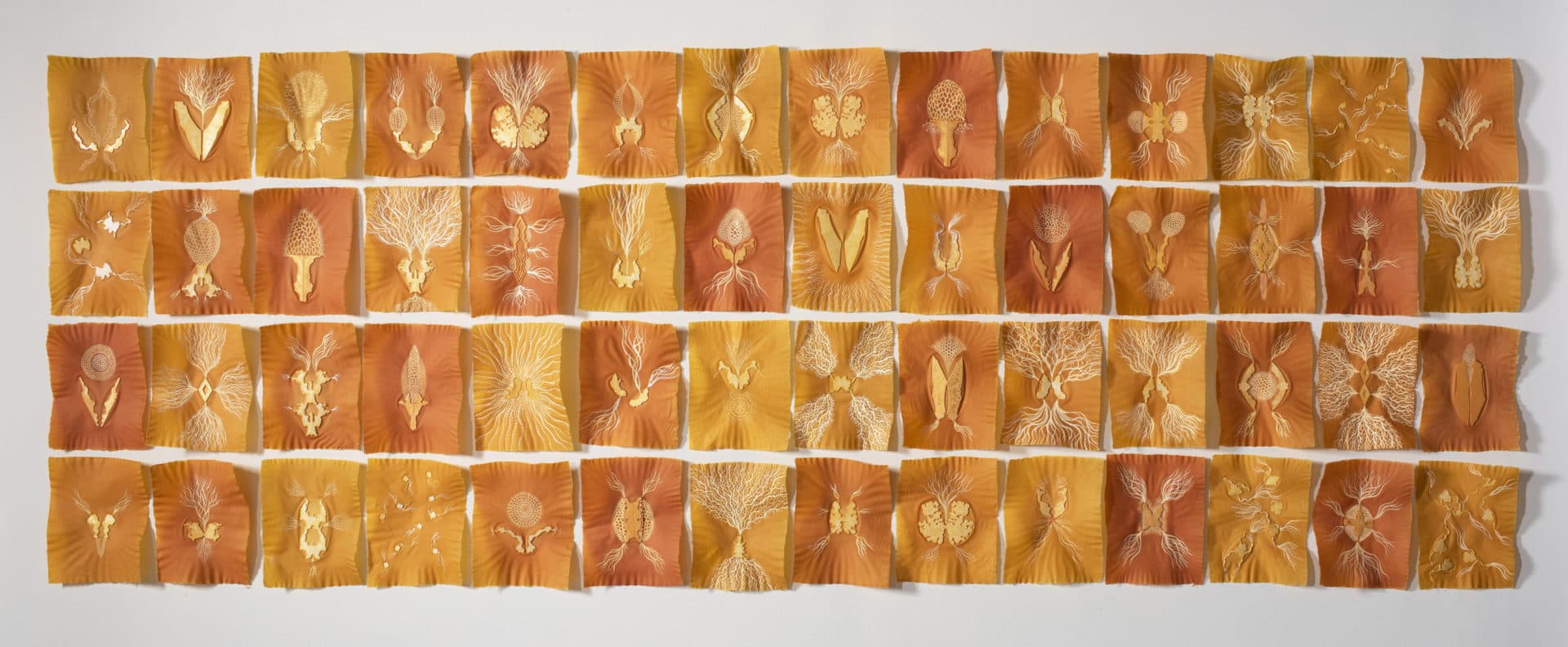In Michelle Samour’s childhood home, a magnificent Persian carpet graced the living room floor. The rug was packed with pattern — deep reds, navy blues, soft greens — that were geometric in style but organic in feeling. The carpet was just one object among several that was a touchstone to a region of the world that Samour never knew, but that was, in fact, her ancestral home. Samour’s father was a Palestinian émigré. He never spoke much about his life in Palestine, but Samour nevertheless absorbed some of its visual language through incidental objects scattered about the house, including an embroidered vest, an ornate jewelry box belonging to her grandmother, and a mother of pearl compact that was a gift from Samour’s father to her mother.

“Visually, it was very much a part of my growing up,” says Samour, a professor of print and printmaking at the School of the Museum of Fine Arts at Tufts University. (She will retire this year and has already moved to Bennington, Vermont where she plans on building a studio.)
Samour has adopted the visual vocabulary of the Middle East in “Mapping Borders and Boundaries,” on view through Sept. 19 at Fuller Craft Museum. Investigating concepts of homeland, exile and diaspora, her work, at first glance, might appear purely decorative, but on second look reveals a deeper substrate thick with political and philosophical considerations.
We see large colorful paintings on Plexiglas, reminiscent of the type of pattern that Samour observed on her childhood Persian rug. But there’s a trick. Those geometric patterns that might seem to be simply abstracted foliage or random abstract shapes are actually outlines of Palestinian territories and Israeli settlements, specifically, the West Bank, Gaza and Jerusalem. They have been traced and mirrored to create a “reverse painting” of decorative symmetry. Underneath the first layer of Plexiglas painted in jewel-toned translucent and opaque color is a second layer of luminescent foil, similar to the green foil peeking out beneath the mother of pearl compact that Samour’s father gave her mother. The technique is called tinsel painting and is common, along with mother of pearl and abalone handiwork, in objects made in Bethlehem.
Samour’s use of indigenous design is an elegant and adroitly succinct way to celebrate the cultural history of the region while at the same time subversively critiquing it. The jewel-tone colors in some of the paintings in the exhibition speak to the preciousness of land while also drawing a pointed contrast to the history of conflict in the region.
“I've been working that way for quite a while and then I realized the connection,” she says of her reverse paintings. “That was sort of a way for me to talk about my father's history and being part of the Palestinian diaspora. I had always wanted to talk about it, but I really wanted to make sure that it felt right, that there was a connection already to the work that I was doing.”

The questions inherent in her work penetrate much deeper than mere surface decoration. What place do we call home? Who, or what, gives us the right to call that place home? What happens when you lose your home?
“The original title of this series was ‘Borders and Boundaries: Looking for Palestine,’” says Samour. “But I felt like that was too specific as a title because I wanted the work to be a catalyst for conversation about not just that part of the world, but what's happening in all parts of the world, in terms of the redefinition of borders and boundaries.”
Samour’s art practice has long leaned toward a robust materiality. She doesn’t just paint. Past works have seen her manipulate pigmented abaca fiber into sculptural shapes and build two-layered lightboxes to provide a multi-dimensional view of our microbic world. In this exhibit, her physical approach continues with two other bodies of work, “Land of Milk and Honey: A Story” and “Milk and Honey: Stuck.”
In “A Story,” Samour creates mixed media works on small panels that incorporate burnt wood, milk paint, bee’s wax, plaster and steel. Samour takes wooden tablets, some painted white, and sands them as a metaphor for loss and disappearance. She says she was also referencing the wooden construction of the jewelry box that belonged to her grandmother and was later given to her mother. On those family heirlooms, mother of pearl and abalone pieces had become unglued, exposing the raw wood.
“I thought this was a good metaphor for what was happening to the Palestinians leading up to the partition of Palestine to the formation of Israel and the ongoing conflict,” she says.

Samour drills holes into her wooden tablets and burns them, yet another way to discuss the loss and destruction of the Palestinian homeland. The work, with embedded shards of wood in beeswax, was Samour’s expression of the cyclical nature of history as well as “the 'containment' of the Palestinians where leaving is difficult and staying can be even more so.”
In “Stuck,” Samour cuts iridescent acrylic paint reminiscent of mother of pearl, into the shapes of Israel, Palestine, the West Bank, Gaza, Jerusalem and the settlements. She then embeds the fragments into sheets of glowing orange-yellow abaca paper. She coats the paper in a layer of white gouache. The title of the piece references the biblical phrase of the “land of milk and honey” referring to the promised land of Jewish tradition. The question, implicit in the piece is who is this “promised land” for?
“This whole idea of talking about Israel and Palestine can be so difficult because people are so invested, understandably, in the story, whether you're Jewish or Christian or Muslim,” says Samour. “It's a hard story to talk about without people becoming angry and territorial and not listening. I just wanted to be careful with all of this work to present it in a more subtle way, to make the work hopefully curious and invite people into thinking about what this might mean for both sides.”
“Michelle Samour: Mapping Borders and Boundaries” is at Fuller Craft Museum from March 2 (the day the museum reopens) through Sept. 19.
"craft" - Google News
March 01, 2021 at 05:11PM
https://ift.tt/3sDFnva
At Fuller Craft, Artist Michelle Samour Transcends Borders And Boundaries - WBUR
"craft" - Google News
https://ift.tt/2YrY2MS
Shoes Man Tutorial
Pos News Update
Meme Update
Korean Entertainment News
Japan News Update
Bagikan Berita Ini














0 Response to "At Fuller Craft, Artist Michelle Samour Transcends Borders And Boundaries - WBUR"
Post a Comment